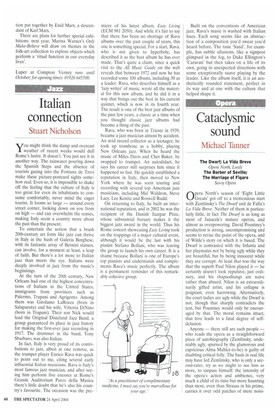A life in suitcases
Elisabeth Anderson
At the time of year when we may be planning a summer holiday, Peter Greenaway's installation of suitcases is perhaps an apt subject for the opening exhibition at Compton Verney in Warwickshire. Luper at Compton Verney shows a collection of 92 suitcases (belonging to Greenaway's fictional character Tulse Luper), which are positioned round the house.
Luper is associated with a 'life history of 92 suitcases, and since 92 is the atomic number of uranium we can make that fact significant', explains Greenaway in a typically enigmatic way. 'As an inveterate collector, collater and classifier, packing suitcases, leaving them in appropriate and inappropriate places, having them stolen, repacked, abandoning them or being persuaded to abandon them, was endemic with Luper,' continues Greenaway. Inside each suitcase is something significant in Luper's life. So, for example, we have no. 60: a suitcase of broken glass and broken mirrors, Luper's representation of chance escapes and bad luck; and no. 29: a suitcase of lightbulbs, witnesses of ambiguous events, in conditions of poor light and total darkness.
The great hall of Compton Verney is filled with a further 92 suitcases, all empty, hanging from and partly obscuring the ornate Robert Adam ceiling. Adam had been asked by the Verney family to remodel the existing Baroque house in 1760, and later Capability Brown was employed to relandscape the grounds; he also built a chapel adjacent to the house. The house remained in the Verney family until the 1920s, then changed hands several times, and by the 1980s had become semi-derelict. In 1993 the Peter Moores Foundation came to the rescue and bought the property.
Over the past ten years, Sir Peter Moores has committed .E64 million to the renovation of the house and grounds, the building of a new gallery (by the architects Stanton Williams) and the acquisition of works of art for the permanent collections. These reflect Sir Peter's eclectic taste. So there are Neapolitan 17thand 18th-century landscapes, religious and classical paintings, and still lives; late mediaeval art from Germany; and a small collection of British portraits. There is also an outstanding collection of Chinese bronzes and pottery, including vessels dating from the early Shang Dynasty (about 1500 to 1050 BC).
Andras Kalman's collection of British folk art was acquired by the Foundation in 1993 and is also now on permanent display. This is a hugely enjoyable hotchpotch of items, including shop signs, a child's pull-along wooden model of a bull, a fairground carousel pig and various Staffordshire figures. There is also a tin tray on which Alfred Wallis has painted a ship with red sails coming into harbour. Next door to the folk art is a textile collec tion put together by Enid Marx, a descendant of Karl Marx.
There are plans for further special exhibitions: next year, Marina Warner's Only Make-Believe will draw on themes in the folk-art collection to explore objects which perform a 'ritual function in our everyday lives'.
Luper at Compton Verney runs until October; for opening times: 01926 645500.



















































































 Previous page
Previous page